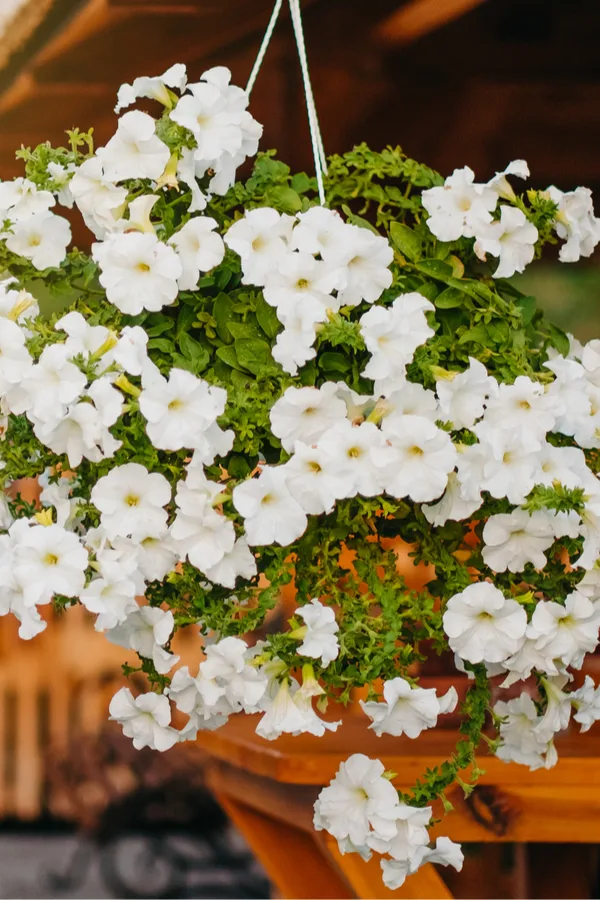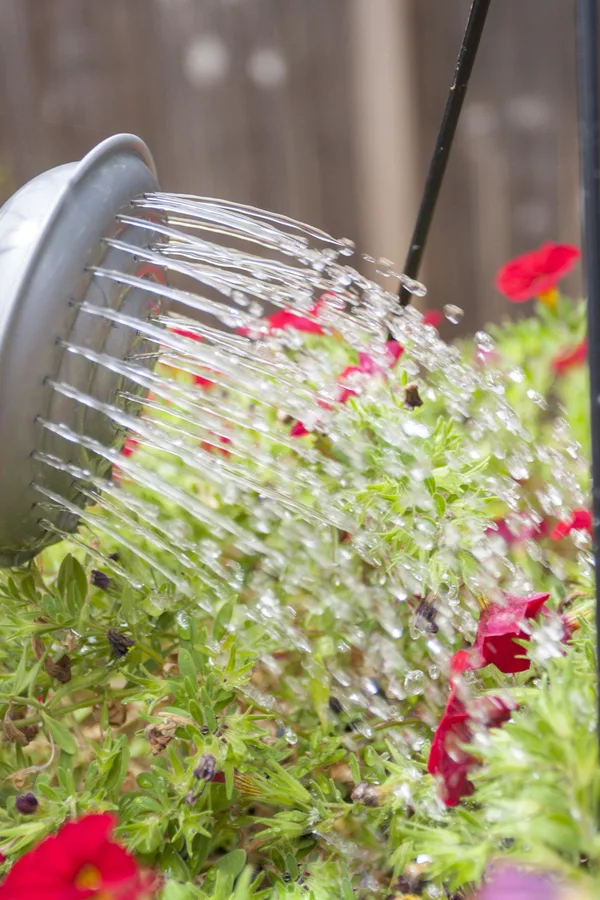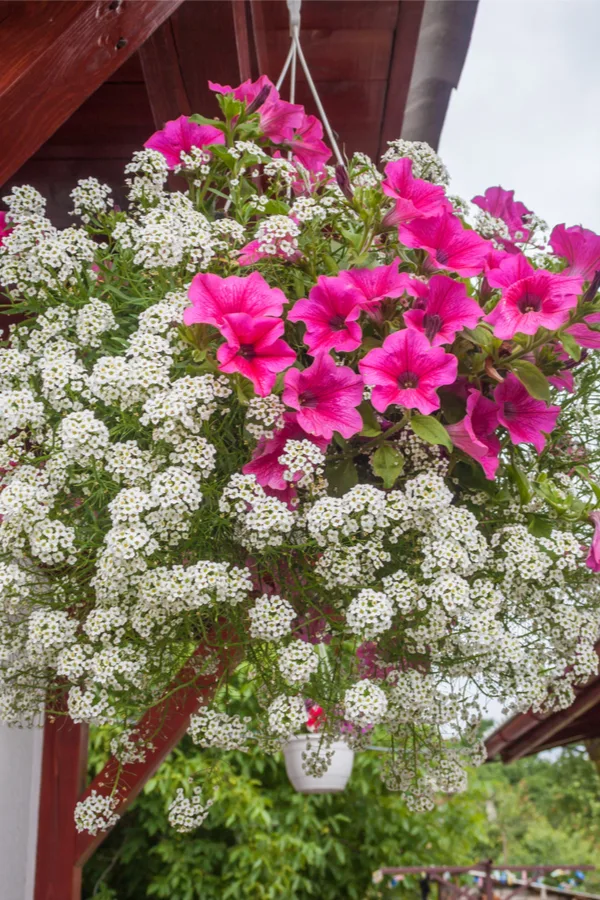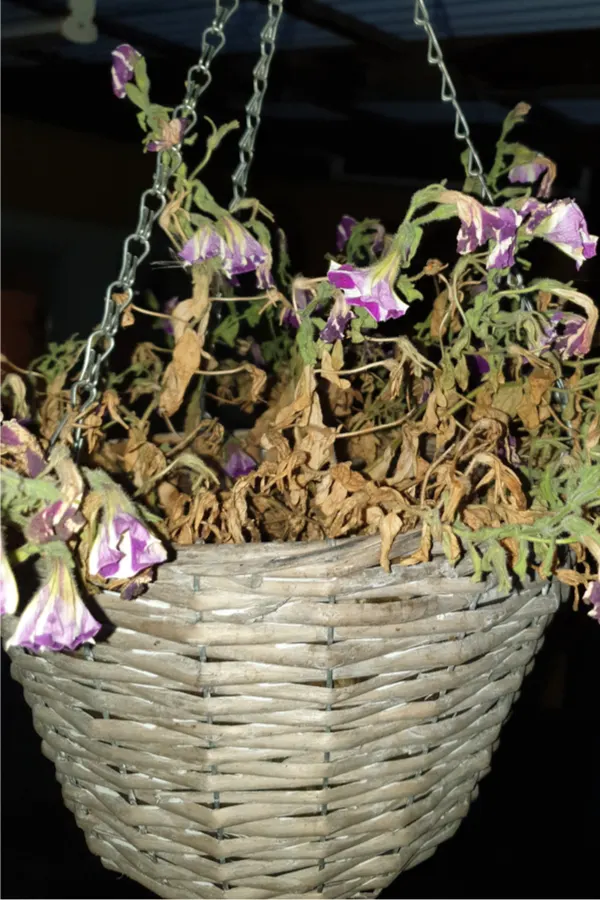Want to keep your hanging baskets blooming and booming strong all summer long this year?
One of the best things about a flowering hanging basket is that it brings instant color and interest anywhere. Whether on a front porch, back porch, patio, or perched on a post in the middle of the yard, it can brighten up any space with a welcoming array of blooms.
Flowering baskets have so many advantages over traditional flowerbed plantings. There is little worry of animals digging them up or devouring them. Nor is there ever a concern about constantly having to weed them week after week.

But with all of those advantages, there is one issue that seems to plague gardeners when it comes to their hanging baskets. And that issue? How to keep them flowering strong for an entire growing season!
Unfortunately, by mid to late summer, a large majority of hanging baskets begin to rapidly fade. What was once a bright bouquet of foliage and blooms often turn into an eyesore filled with brown leaves and a sparse collection of struggling flowers.
But it truly doesn’t have to be that way! In fact, with just a few simple tips you can keep your baskets thriving and gorgeous all the way through summer and deep into fall. With that in mind – here is a look at the secrets to success for keeping your baskets booming with color!
The 3 Keys To Keep Hanging Baskets Blooming & Beautiful
#1 Consistent Watering
Without a doubt, consistent watering is the single biggest key to keeping your hanging baskets in tip top shape. In fact, the quickest way to shorten the life of a flowering basket is by either overwatering, or underwatering.
Too much water will swell and flood the root structure of any container plant. When that happens, the swollen, water-logged roots become unable to absorb nutrients.

With infrequent or inadequate watering, baskets suffer as well. Without enough moisture, plants struggle to grow. As leaves and roots wilt and shrink without water, the plant is unable to produce new growth or blooms – and the stress can be highly damaging to its long term success.
The key to watering success is consistency. Get in the habit of checking and watering your baskets at the same time every day. Not only does it help the plant with regular watering, it helps you to remember to do it!
Always check the soil for moisture before adding water. Use an inexpensive moisture probe meter to tell if your soil is dry at the root level, or check by sticking your finger into the soil about an inch to see if there is any moisture.
If plants have moisture at the roots, hold off on watering until needed. As for when to water, the best time is early in the morning. Morning water helps plants hydrate quickly and prepares them for the long, hot day ahead.
#2 Fertilizing For Success – How To Keep Hanging Baskets Blooming All Summer
Hanging basket plants, just as with any plant growing in a container, has a limited amount of nutrients it can pull from the soil. Even if you use the best planting mix, it will eventually run out of power. Because of this, fertilizing is a must for long term success.
We use a two-fold approach for fertilizing to keep a steady supply of nutrients on hand. First, we apply a 1/4 cup of worm castings to the top of the baskets soil every month. Worm castings are the perfect slow release fertilizer.
Every time you water, the nutrients leach down through the soil and absorb into the roots. And not only do they help feed your plant, they also help absorb and hold moisture too. Product Link: Pure Worm Castings
If worm casting aren’t available, you can substitute the monthly feeding with a good quality all-purpose granular fertilizer to supply low and slow power as well. Simply apply on top of the soil as you would with the worm castings.
Liquid Fertilizer – The Secret Punch of Power
In addition to the low and slow fertilizing, we also water with a liquid fertilizer (compost tea or worm casting tea) every two weeks. Liquid fertilizer acts fast, and keeps plants supplied with ready-to-go power.
The two-week schedule keeps the plants blooming, but without being too aggressive in their growth. Unfortunately, too much fertilizer will result in the plant becoming root-bound quickly.

#3 Removing Spent Blooms – How To Keep Hanging Baskets Blooming All Summer
Finally, to keep your plants flourishing with a continuous supply of new blooms week after week, deadheading spent flowers is a must!
This simple practice of removing old or fading blooms helps the plant to send and spend its energy where it matters most, on new blooms. Take a few minutes when watering to remove blooms that are past their prime. This little act will pay off big in keeping new flowers coming on continuously!
It is amazing how simply clearing old blooms off a plant one day can mean hundreds of new blooms just a few days later. See: How To Deadhead Flowers For More Blooms!
When A Plant Outgrows Its Basket – How To Keep Hanging Baskets Blooming All Summer
Sometimes, a plant simply becomes too large for its basket and becomes root bound. This is especially true for hanging baskets that were purchased as large plants in the spring.
Once a plant becomes root bound, no amount of effort is going to keep it thriving in the same container. But whatever you do, don’t throw it away! By simply giving its cramped roots a little more space in a new place, you can bring it back to life. And you can do this with two unique methods.

The first and most common method is to simply replant the overgrown plant into a larger basket or planter. To do this, select a container that is at least 25 to 50% larger.
When repotting root bound plants, be sure to loosen the roots a bit before replanting. Add in a high quality potting soil around the root ball, and pack firmly into the new container. Water well, fertilize, and watch your plant take off again!
Planting Into The Landscape – How To Keep Hanging Baskets Blooming All Summer
Another great alternative to repotting into a larger container is to plant your overgrown hanging basket right into the landscape.
Simply dig a hole into your flowerbeds a few inches larger than the root ball. Next, add in a bit of compost to the planting hole, water in and cover with soil. With all the room in the world to grow, the once-crowded root ball and the plants will thrive – allowing you to enjoy even more flowers the rest of the growing season.
Here’s to keeping your hanging baskets blooming and gorgeous all summer long Jim and Mary!
Jim and Mary Competti have been writing gardening, DIY and recipe articles and books for over 15 years from their 46 acre Ohio farm. The two are frequent speakers on all things gardening and love to travel in their spare time.
As always, feel free to email us at thefarm@owgarden.com with comments, questions, or to simply say hello! You can sign up for our free email list in the subscribe now box in the middle of this article. Follow us on Facebook here : OWG Facebook. This article may contain affiliate links.
